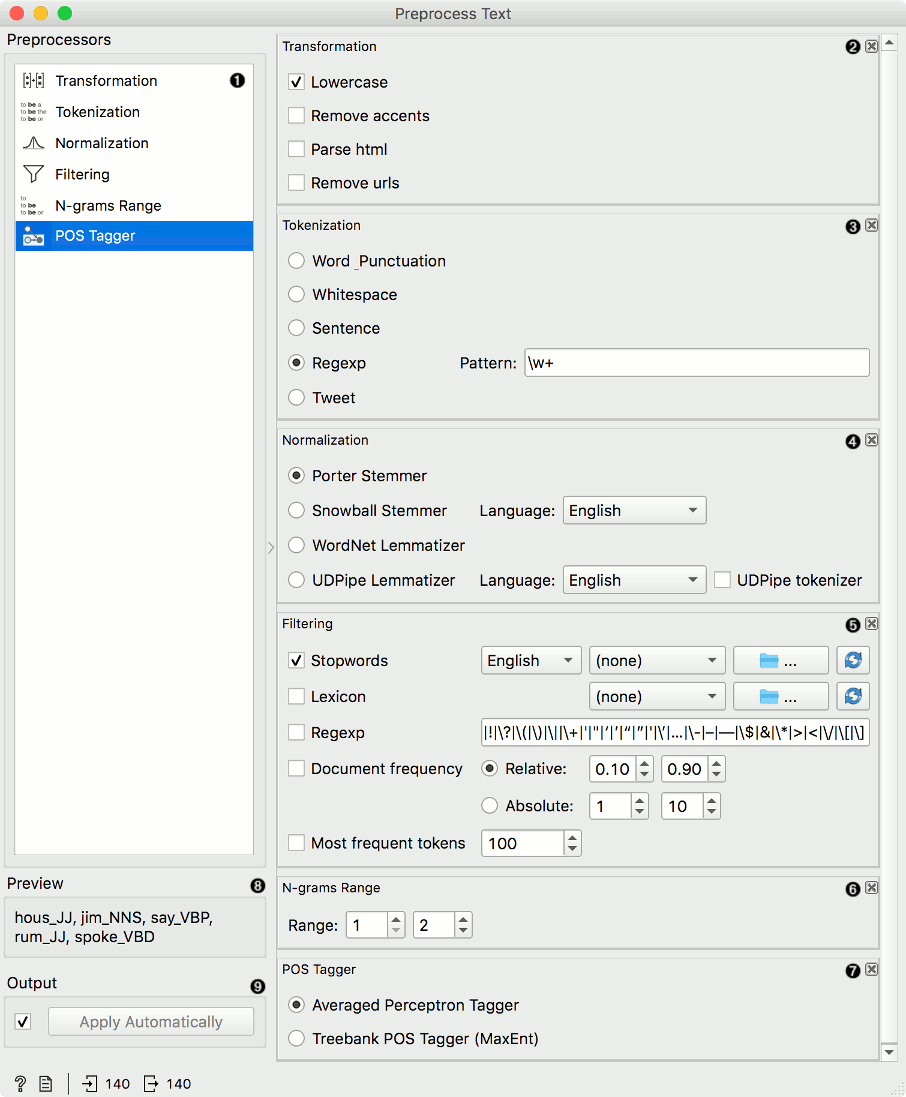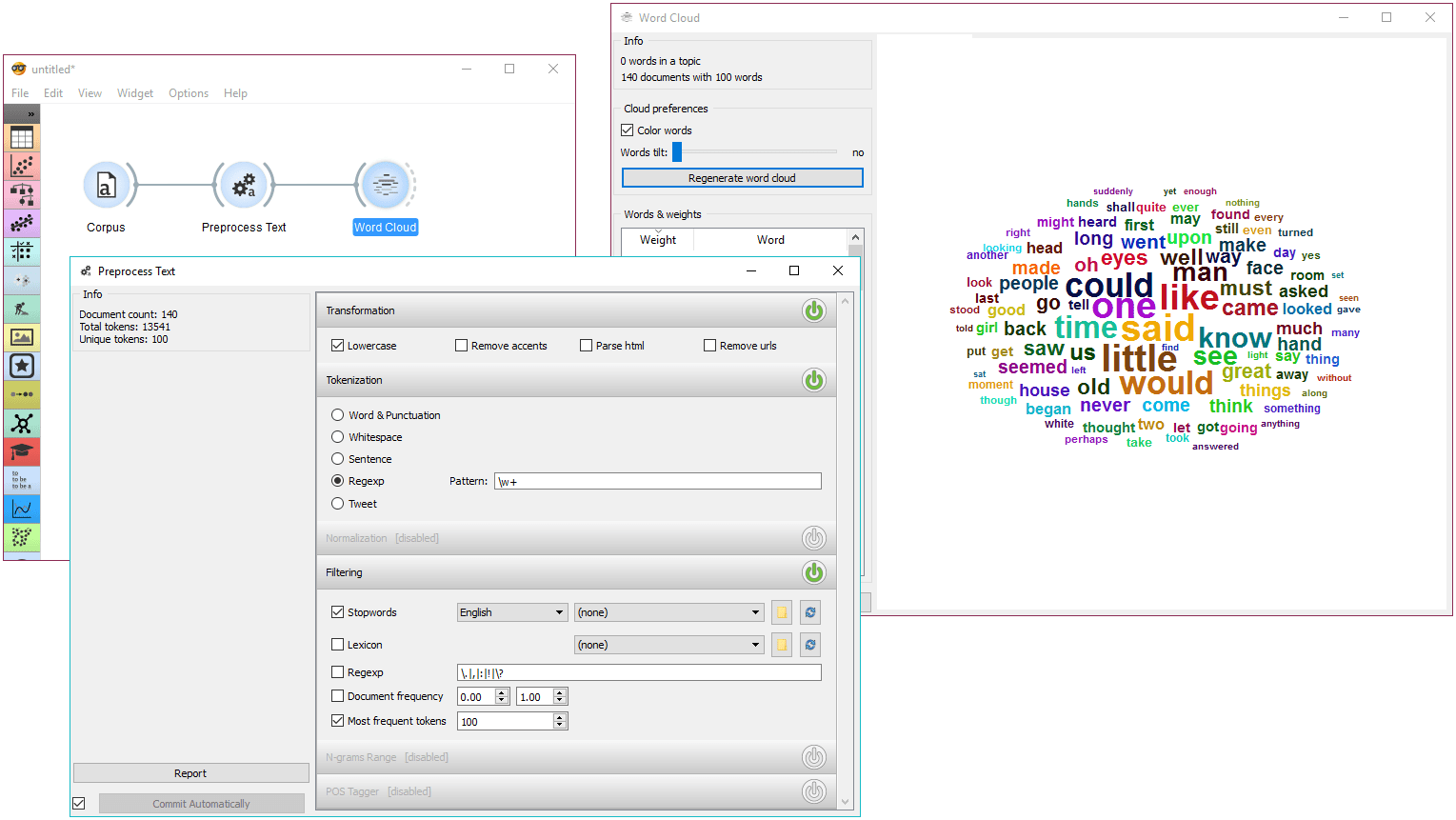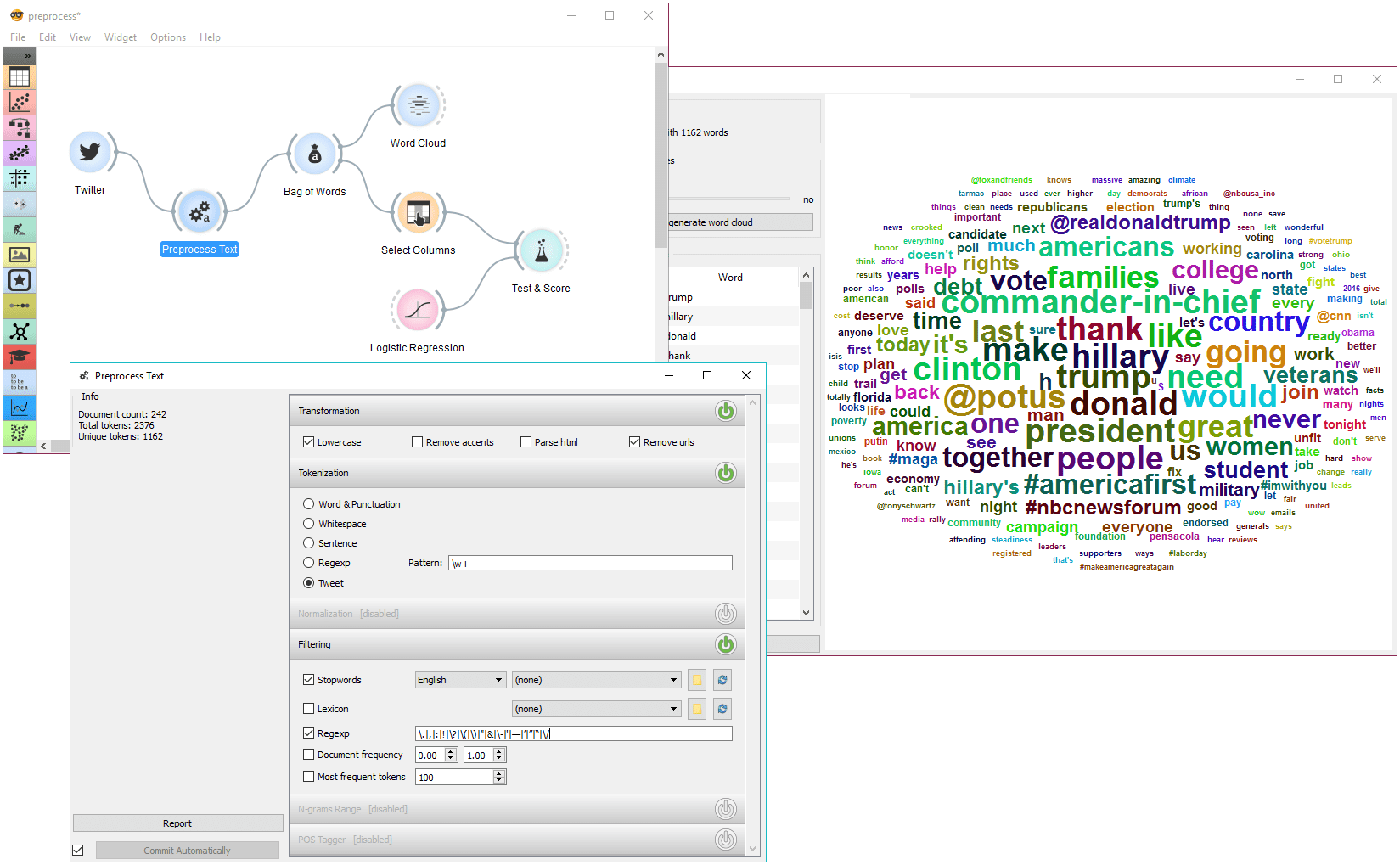Preprocess Text
Preprocesses corpus with selected methods.
Inputs
- Corpus: A collection of documents.
Outputs
- Corpus: Preprocessed corpus.
Preprocess Text splits your text into smaller units (tokens), filters them, runs normalization (stemming, lemmatization), creates n-grams and tags tokens with part-of-speech labels. Steps in the analysis are applied sequentially and can be reordered. Click and drag the preprocessor to change the order.

- Available preprocessors.
- Transformation transforms input data. It applies lowercase transformation by default.
- Lowercase will turn all text to lowercase.
- Remove accents will remove all diacritics/accents in text. naïve → naive
- Parse html will detect html tags and parse out text only. <a href...>Some text</a> → Some text
- Remove urls will remove urls from text. This is a http://orange.biolab.si/ url. → This is a url.
- Tokenization is the method of breaking the text into smaller components (words, sentences, bigrams).
- Word & Punctuation will split the text by words and keep punctuation symbols. This example. → (This), (example), (.)
- Whitespace will split the text by whitespace only. This example. → (This), (example.)
- Sentence will split the text by full stop, retaining only full sentences. This example. Another example. → (This example.), (Another example.)
- Regexp will split the text by provided regex. It splits by words only by default (omits punctuation).
- Tweet will split the text by pre-trained Twitter model, which keeps hashtags, emoticons and other special symbols. This example. :-) #simple → (This), (example), (.), (:-)), (#simple)
- Normalization applies stemming and lemmatization to words. (I've always loved cats. → I have alway love cat.) For languages other than English use Snowball Stemmer (offers languages available in its NLTK implementation) or UDPipe.
- Porter Stemmer applies the original Porter stemmer.
- Snowball Stemmer applies an improved version of Porter stemmer (Porter2). Set the language for normalization, default is English.
- WordNet Lemmatizer applies a networks of cognitive synonyms to tokens based on a large lexical database of English.
- UDPipe applies a pre-trained model for normalizing data.
- Lemmagen applies a pre-trained model for normalizing data.
- Filtering removes or keeps a selection of words.
- Stopwords removes stopwords from text (e.g. removes 'and', 'or', 'in'...). Select the language to filter by, English is set as default. You can also load your own list of stopwords provided in a simple *.txt file with one stopword per line.
 Click 'browse' icon to select the file containing stopwords. If the file was properly loaded, its name will be displayed next to pre-loaded stopwords. Change 'English' to 'None' if you wish to filter out only the provided stopwords. Click 'reload' icon to reload the list of stopwords.
Click 'browse' icon to select the file containing stopwords. If the file was properly loaded, its name will be displayed next to pre-loaded stopwords. Change 'English' to 'None' if you wish to filter out only the provided stopwords. Click 'reload' icon to reload the list of stopwords. - Lexicon keeps only words provided in the file. Load a *.txt file with one word per line to use as lexicon. Click 'reload' icon to reload the lexicon.
- Regexp removes words that match the regular expression. Default is set to remove punctuation.
- Document frequency keeps tokens that appear in not less than and not more than the specified number / percentage of documents. Absolute keeps only tokens that appear in the specified number of documents. E.g. DF = (3, 5) keeps only tokens that appear in 3 or more and 5 or less documents. Relative keeps only tokens that appear in the specified percentage of documents. E.g. DF = (0.3, 0.5) keeps only tokens that appear in 30% to 50% of documents.
- Most frequent tokens keeps only the specified number of most frequent tokens. Default is a 100 most frequent tokens.
- Stopwords removes stopwords from text (e.g. removes 'and', 'or', 'in'...). Select the language to filter by, English is set as default. You can also load your own list of stopwords provided in a simple *.txt file with one stopword per line.
- N-grams Range creates n-grams from tokens. Numbers specify the range of n-grams. Default returns one-grams and two-grams.
- POS Tagger runs part-of-speech tagging on tokens.
- Averaged Perceptron Tagger runs POS tagging with Matthew Honnibal's averaged perceptron tagger.
- Treebank POS Tagger (MaxEnt) runs POS tagging with a trained Penn Treebank model.
- Preview of preprocessed data.
- If Commit Automatically is on, changes are communicated automatically. Alternatively press Commit.
Note! Preprocess Text applies preprocessing steps in the order they are listed. A good order is to first transform the text, then apply tokenization, POS tags, normalization, filtering and finally constructs n-grams based on given tokens. This is especially important for WordNet Lemmatizer since it requires POS tags for proper normalization.
Useful Regular Expressions
Here are some useful regular expressions for quick filtering:
\bword\b: matches exact word
\w+: matches only words, no punctuation
\b(B|b)\w+\b: matches words beginning with the letter b
\w{4,}: matches words that are longer than 4 characters
\b\w+(Y|y)\b: matches words ending with the letter y
Examples
In the first example we will observe the effects of preprocessing on our text. We are working with book-excerpts.tab that we've loaded with Corpus widget. We have connected Preprocess Text to Corpus and retained default preprocessing methods (lowercase, per-word tokenization and stopword removal). The only additional parameter we've added as outputting only the first 100 most frequent tokens. Then we connected Preprocess Text with Word Cloud to observe words that are the most frequent in our text. Play around with different parameters, to see how they transform the output.

The second example is slightly more complex. We first acquired our data with Twitter widget. We quired the internet for tweets from users @HillaryClinton and @realDonaldTrump and got their tweets from the past two weeks, 242 in total.

In Preprocess Text there's Tweet tokenization available, which retains hashtags, emojis, mentions and so on. However, this tokenizer doesn't get rid of punctuation, thus we expanded the Regexp filtering with symbols that we wanted to get rid of. We ended up with word-only tokens, which we displayed in Word Cloud. Then we created a schema for predicting author based on tweet content, which is explained in more details in the documentation for Twitter widget.